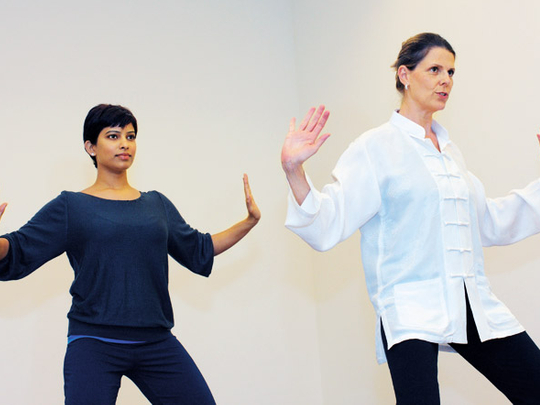
She has through meditation found the strength to extricate herself out of a waist-deep mudslide and speed the healing process of painful gallstones - and I, shamefully, cannot hold my arms above my head for more than five minutes.
Deana Wyland-Fries used qigong (pronounced chi kung), an ancient Chinese practice of postures, breathing techniques and mental focus exercises, to achieve these seemingly unconquerable feats.
She can hold the same stationary standing posture - feet shoulder-width apart, knees slightly bent and hands above the head - for up to an hour.
But my arms aren't cooperating. Neither are my quadriceps, which are quivering like jelly on vibrate mode. My muscles form a cabal with my neurons, sending conspiratorial signals to make me whine.
"Aww," I say, and plunk my arms down faster than a karate chop - with far less dexterity, of course. I stand up straight, missing the aim of qigong entirely - which is to use my breath and my mind to overcome my physical pain.
"It [qigong] is the basis of all martial arts. In kung fu schools in China, you learn qigong before you learn how to fight. It gives you an incredible sense of power from within," says Wyland-Fries.
The moment I hear martial arts, I think of how, in the movie Karate Kid I, Daniel LaRusso (played by Ralph Macchio) inured the one leg stance training, balancing on a wooden stump.
Me? I was on two feet with weight distributed evenly, unable to assuage the physical agony and hold out.
Before I arrived at the Quantum Health Club at The Monarch Dubai, I'd watched a few online videos on qigong to orient myself with the discipline. ‘Simple enough,' I remember thinking, until my less than graceful display - a crumple of flagging legs and arms.
As a beginner, I have to train my body through standing, sitting or lying postures as well as forms (a sequence of exercises) to understand how energy flows within my body and control that energy. I will learn three or four postures or breathing positions today, and hopefully advance to 30-40 with practice. Some postures last from one minute to three minutes, others up to two hours.
"In some postures, you don't move - just breathe," says Wyland-Fries.
Earlier we went through a few stretching moves including touching the floor, palms flat, legs straight. I bent over effortlessly, mentally high-fiving my previous dabbling in yoga, kickboxing and karate.
For my next (standing) posture, she asks me to move my arms, which are stretched out in front of my body, elbows slightly bent in line with my waist - outwards. I do, gliding them gently like paper aeroplanes. Then she asks me to bring them back close together (towards the centre line of my body). But this time, she says I have to compress an imaginary fixed object between my hands.
"Think of it as an isometric exercise [where you push part of the body against resistance] without the fixed object," she suggests helpfully.
In other words, I have to contract my arm muscles when drawing my hands towards each other, thus turning the relaxed gliding movement into a forcible one.
I create an imaginary ball of energy between my hands. The idea is to draw the energy towards my body while keeping my breathing constant. Tiny beads of sweat festoon my brows. The exercise that seemed effortless at first, in reality, isn't.
Wyland-Fries then demonstrates another breathing posture where I have to breathe using my abdomen. She describes it as "very powerful".
I follow her lead. I position my hands on my abdomen, placing my thumbs on my bellybutton, index fingers touching, forming a kind of inverted triangle.
"Inhale into your abdomen through the nose - placing the tip of your tongue on the back of your teeth - and exhale through your mouth [relaxed tongue]. Do this several times," she says.
At first, it feels slightly strange. No, let me rephrase: very strange. I inflate and deflate my stomach like a balloon, feeling a little silly.
Once I get over the awkwardness, I begin to focus on the space between my hands and feel warmth emanating from within.
Eureka! I break into a smile saying, "I felt something build up. Something I don't recognise."
She replies, "You are learning to cultivate energy from within your body and from around you."
Having spent 45 minutes on an introduction to qigong, we sit down to chat. Wyland-Fries is a graduate of the Imperial School of Feng Shui under Master Chun Kun Wah in the UK and of Dr Ilchi Lee's Human Technology School in London. She is a member of the British Holistic Medical Association and of the Chue Foundation in the UK. She is also a feng shui practitioner and teacher, and mother of three children.
She has been teaching qigong for five years, first in London, now in Dubai. She tells me that the feeling of warmth I experienced is energy work. Some exercises increase the flow of qi, others circulate it, and others store the energy to cleanse and heal the body.
She speaks of the mind-body connection where one learns to control the body with the mind.
"How is it different from yoga?" I ask.
"There are several similarities, but qigong puts you in touch with who you are in a very quick and powerful way. Perhaps someone who has practised tai chi, yoga or Pilates is a little more flexible and has a better idea of what I teach, but anyone can do qigong. My dad is 84. He does it. I have a student in a wheelchair who practises qigong," she says.
I probe further: "If it is as powerful as that, why is it arcane? Why hasn't it become a run-of-the-mill venture as yoga has?"
"It's true, it hasn't," she replies. "In general, people are scared to know who they are and what they are made of, and qigong immediately puts them in touch with themselves, requiring them to live more consciously."
I stare at her with incredulity. Is she pulling a modern-day equivalent of the emperor's new clothes trick on me? I tell her I watched an online video of a person using qigong to set a piece of paper on fire, mentioning my stupefied reaction.
Sensing my scepticism, she shares her students' reactions. "They [students] have freaked out after they realised how powerful qigong is. A few never came back. Just one class can start the healing process and set emotions and energy in motion. A student once told me that she cried for three days and was afraid to come back lest she cry in public. Qigong is powerful, but I have never seen anyone set paper on fire. I seriously doubt the validity [of the video]; I need to check it out for myself."
Such reactions, she tells me, are normal. "The biggest challenge for a beginner is to stick with it everyday even if one does so for only five minutes."
I learn of the benefits. I will feel more connected and balanced and will be able to reduce depression and stress-related disorders. I will also be able to improve my cardiovascular system, lymphatic and digestive functions.
"We live in a society in which we run to the doctor if we have a headache or a tummy ache instead of listening to our bodies. Ailments are imbalances of energy. If you understand that energy, you can act proactively and do something about it before it ends in illness. With qigong, you have inner strength, and with that strength there's almost nothing you cannot do," she says.
Wyland-Fries speaks from experience. In 2002, she was diagnosed with skin cancer. "I managed to get through the illness through meditation and qigong. I've also had numerous medical conditions from kidney stones to gallstones, and managed these too with the help of the discipline."
Her own story emboldened her to teach qigong. "It's so powerful in helping people help themselves. On the days that I don't practise, I'm nowhere nearly as effective as I am when I do, even if I do so for 10 to 15 minutes. What's more is that it provides me with a great sense of power and joy."
She speaks of another time when she harnessed the power of qigong to free herself from a landslide in the South of England. "I was fossil hunting with my eldest son Xavier and his school group. I heard him shout, ‘Mom, I am stuck'. He was up to his calves in mud. I rushed over and pulled him out, but got stuck myself. I waited for help.
"Forty-five minutes passed and I was sinking deeper. The panic set in and suddenly I asked myself, ‘Why have you been practising qigong?' I used my inner strength, twisting my body, freeing my legs and pushing myself out. When the coastguard arrived, he simply gaped in disbelief."
I listen intently, wondering if I'll ever find myself in a perilous situation in which I might make use of the mind mastery of qigong. So I ask her of the discipline's everyday application. "Can I use it to alleviate stress in the office?"
"You can use qigong anywhere - while driving or sitting at your desk," says Wyland-Fries, whose upcoming four-week course titled Harnessing the Qi will start in a few weeks' time .
She proceeds to teach me a few de-stressing exercises which I plan to use when I'm back at my desk.
-For more information email info@re-balance.eu
Facts about qigong
- It is used to balance energy in a person's body
- It can be adapted for every age and ability, even the physically challenged
- The first stage is body tapping which involves gently striking parts of your body - from the head to the toes - to clear blockages and encourage energy flow
- If practised on a daily basis it is very powerful and will immediately realign the energy in your body
- Losing weight is a by-product of the discipline, not the primary goal which is to feel more connected











